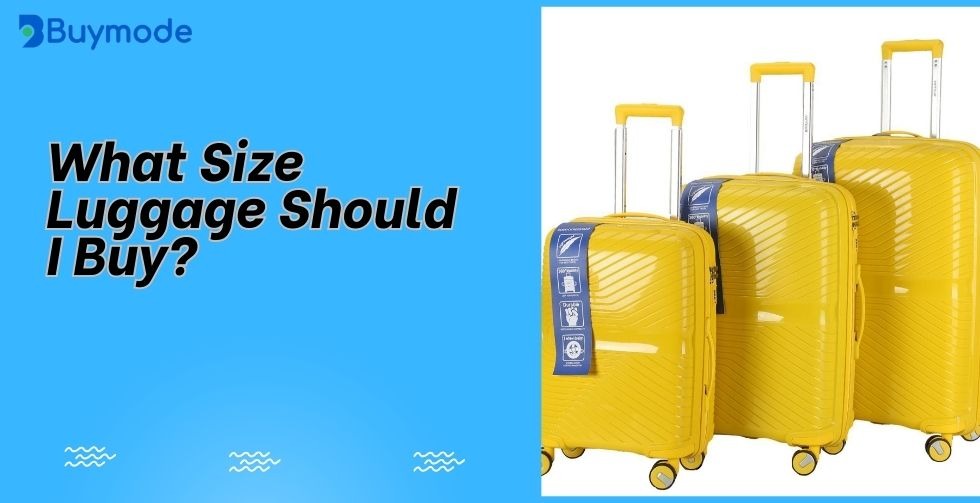
What Size Luggage Should I Buy: Buying Guide
Packing for a trip can be both exciting and overwhelming, especially when it comes to choosing the right luggage. The size of your suitcase can make or break your travel experience, affecting everything from convenience to airline compliance. If you’ve ever wondered, what size luggage should I buy, the answer depends on your travel needs.
For short trips, you should choose a carry-on (18-22 inches) to meet airline rules. Week-long travels suit medium luggage (23-26 inches), while extended stays require large suitcases (27-32 inches) for extra space.
Always consider airline limits, storage space, and weight restrictions before making a decision. Want to learn more? Keep reading to find the perfect luggage for your next adventure!
What Size Luggage Should I Buy?
When it comes to buying luggage, the size you choose can significantly impact your travel experience. Selecting the right suitcase depends on the length of your trip, the nature of your travel, and your personal packing habits. Whether you're heading out for a weekend getaway or preparing for an extended overseas stay, you should be aware of the different suitcase sizes and their intended uses. Here's how to determine what size luggage to purchase:
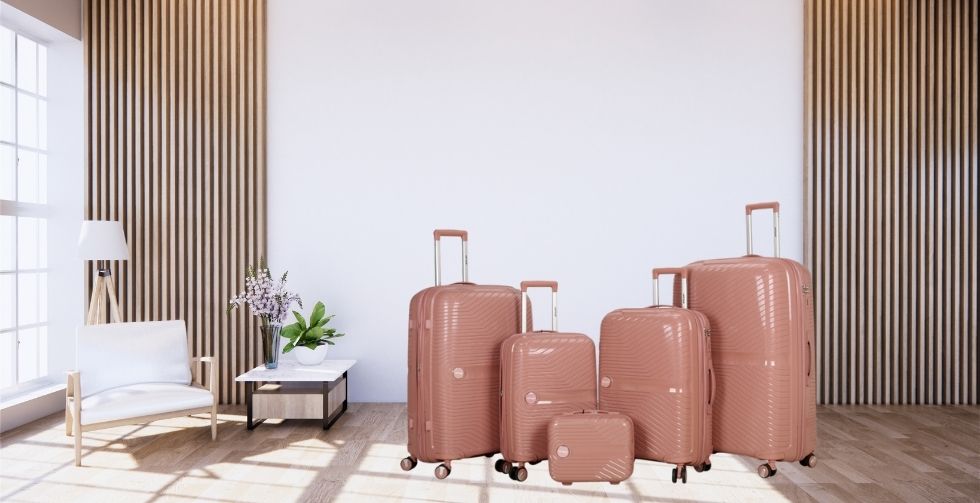
Trip Duration
The length of your trip is a primary factor in selecting luggage size. For short trips lasting a few days, a small carry-on suitcase is sufficient. These typically range from 18 to 22 inches and fit in overhead compartments, perfect for avoiding checked baggage fees. For journeys spanning a week, consider a medium-sized suitcase, which usually measures between 23 and 26 inches.
Travel Frequency
If you travel often, durability and size adaptability become crucial. Frequent travelers benefit from investing in a versatile suitcase that withstands constant use. A high-quality, medium-sized suitcase can be ideal for both short business trips and longer vacations, offering a good balance between portability and capacity.
Airline Restrictions
Airlines have strict regulations regarding luggage sizes, especially for carry-ons. Choose a suitcase that complies with these limitations to avoid unexpected fees. Smaller carry-on suitcases are generally compatible with most airlines' overhead compartments. Before purchasing, always check the specific size restrictions of the airlines you most frequently fly with.
Packing Habits
Your packing style plays a significant role in the size of luggage you should select. If you tend to pack lightly, a smaller suitcase might suffice for longer trips. Conversely, if you prefer having multiple outfit choices or travel with extra gear like cameras or sports equipment, a larger suitcase is necessary to accommodate everything comfortably.
Destination Needs
Consider the nature of your destination when choosing your luggage size. If you're traveling to a region with variable weather, such as the UAE, you might need additional clothing options that require more space. A medium to large suitcase allows you to pack extra items like coats or boots, which are essential for adapting to different climates.
Storage and Mobility
Think about how you'll store and move your luggage. Larger suitcases provide more packing space but can be difficult to manage and store, especially in tight spaces. If you're navigating crowded airports or using public transport, a more compact, maneuverable suitcase might be the better option.
Cost Considerations
The cost of luggage can vary significantly based on size, brand, and material. Larger suitcases generally cost more but offer more packing space. Balancing cost with your actual travel needs can prevent you from overspending on features you might not use frequently.
When traveling across different countries, such as the UAE, it's important to consider the size of your luggage. This is because local travel conditions and airline regulations may vary, and having the right luggage can help make your journey smoother. So, when shopping for luggage set in UAE, local options might offer products designed to accommodate the region's particular climate and travel conditions, ensuring you have the right gear for your journey.
Different Types of Luggage and Their Purpose
Luggage comes in various shapes and sizes, each designed to serve a specific purpose for different travel needs. Whether you're packing for a short trip or a long vacation, the right luggage can make a big difference. Here are different types of luggage to help you choose the best option for convenience and efficiency.
Carry-On Suitcases
Compact and lightweight, carry-on suitcases are perfect for short trips where checking in luggage isn't necessary. They fit in overhead compartments, making travel smoother and hassle-free. Designed for efficiency, these suitcases typically have organized compartments for essentials like clothing, gadgets, and toiletries. Frequent flyers prefer them to avoid long baggage claim waits and extra airline fees.
Hardshell Luggage
Providing maximum protection, hardshell luggage shields fragile belongings from damage during transit. Made of durable materials like polycarbonate, they resist impact and harsh handling. Ideal for carrying electronics, glassware, or valuables, they keep items secure throughout the journey. Though slightly heavier, their robust design makes them a reliable choice for frequent travelers.
Softshell Luggage
Offering flexibility, softshell luggage expands to accommodate extra items while maintaining a lightweight design. The fabric exterior allows for easy storage in overhead bins or tight spaces. Many models feature exterior pockets for quick access to travel essentials like passports and chargers. Travelers who prioritize convenience over rigidity often prefer this type of suitcase.
Spinner Luggage
Designed for effortless movement, spinner luggage features four multi-directional wheels that glide smoothly across different surfaces. These suitcases reduce strain on arms and wrists by allowing easy maneuverability. Ideal for busy airports, they offer better control in crowded spaces. Whether large or small, they make traveling more convenient for all types of travelers.
Why Does Luggage Size Matter?
Choosing the right luggage size is more important than many travelers realize. It affects convenience, travel costs, and overall ease of movement. The following are reasons why luggage size matters for a comfortable, stress-free, and organized trip.
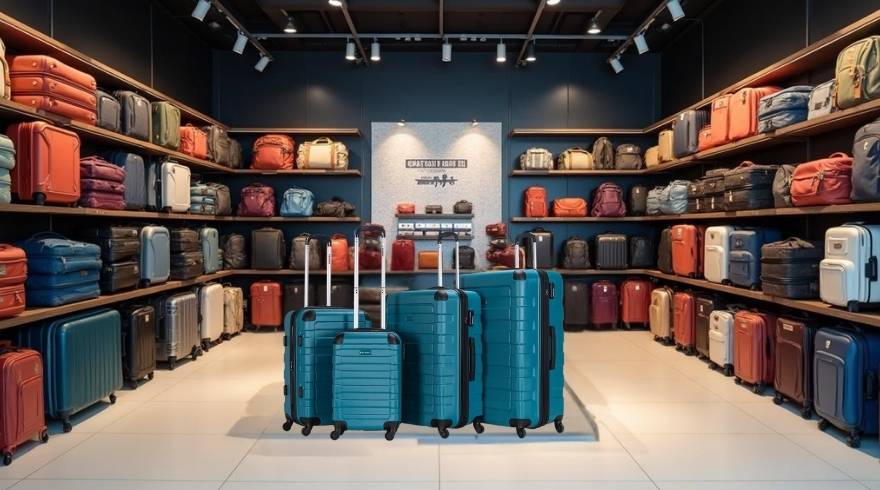
Airline Regulations
Most airlines have strict luggage size policies to ensure smooth boarding and baggage handling. Carry-ons must fit overhead compartments, avoiding unnecessary fees or delays. Oversized luggage often incurs additional costs, which can significantly impact travel budgets. Checking airline restrictions beforehand prevents surprises and makes traveling easier and more efficient.
Packing Efficiency
A suitcase that fits everything without wasting space ensures better organization. Larger luggage provides room for extra outfits, shoes, and travel essentials. Smaller options force travelers to pack only the necessities, avoiding unnecessary bulk. Finding the right balance between space and efficiency makes packing less stressful and more practical.
Mobility and Convenience
Larger suitcases can be difficult to handle, especially in crowded areas or tight spaces. Smaller luggage makes movement smoother in airports, buses, and trains. Rolling spinner wheels and lightweight designs enhance mobility for frequent travelers. Choosing manageable luggage size ensures effortless travel without unnecessary physical strain or inconvenience.
Storage and Accessibility
Bulky luggage takes up more space, making storage at home or in hotels challenging. Compact options fit better in closets, car trunks, and overhead bins. Travelers who move frequently benefit from easily accessible luggage with well-organized compartments. Efficient storage solutions improve overall travel experiences by reducing clutter and maximizing accessibility.
Cost Considerations
Oversized luggage often leads to higher baggage fees and additional airline charges. Budget-conscious travelers prefer carry-ons to avoid unnecessary expenses on flights. Smaller bags also reduce the likelihood of overpacking, which can lead to excess weight fees. Choosing the right size helps travelers manage costs while maintaining comfort and convenience.
Destination and Trip Length
Longer trips typically require more packing space, making larger luggage necessary. Short weekend getaways are easier with compact suitcases that hold only essentials. Destinations with varying climates might require additional clothing layers, affecting luggage size needs. Consider the duration and location of travel when choosing a suitcase.
How to Choose the Right Luggage for Your Needs?
When traveling, choosing the right luggage is essential for a smooth and hassle-free experience. The perfect suitcase depends on your trip length, travel style, and storage needs. Following a step-by-step approach simplifies the decision-making process, helping you find the ideal luggage for your journey.
Step 1: Determine Your Travel Frequency
Frequent travelers need durable luggage that withstands constant use, while occasional travelers might prioritize affordability over longevity. Hard-shell suitcases protect belongings from rough handling, making them ideal for regular flyers. Soft-shell options offer flexibility, which suits those who pack light for short trips. Considering how often you travel helps narrow down choices effectively.
Step 2: Consider the Trip Duration
Short trips require compact carry-ons, while extended vacations demand spacious checked luggage. A small suitcase keeps things light, reducing unnecessary weight and effort. For longer stays, a medium or large suitcase provides enough room for clothing, shoes, and essentials. Matching your luggage size to your trip length ensures practicality without overpacking.
Step 3: Check Airline Regulations
Each airline has specific size and weight limits for carry-on and checked luggage. Choosing a suitcase that meets these restrictions avoids extra fees and inconvenience. A lightweight suitcase with expandable compartments balances compliance and packing flexibility. Reviewing airline baggage policies before purchasing luggage prevents costly surprises at the airport.
Step 4: Assess Storage and Portability
Luggage that fits into tight spaces is easier to handle in crowded places like hotels, trains, and airports. Spinner wheels and retractable handles improve portability, making travel smoother. Overly large suitcases can be difficult to store, especially in compact hotel rooms. Selecting luggage that balances capacity with mobility improves convenience and ease of use.
Step 5: Prioritize Durability and Material
Hard-shell luggage offers better protection against impacts, while soft-shell options provide flexibility for tighter spaces. Water-resistant materials prevent damage in unpredictable weather conditions. Reinforced zippers and sturdy handles extend the lifespan of luggage, ensuring long-term use. Investing in high-quality materials saves money by reducing the need for frequent replacements.
Step 6: Evaluate Security Features
Built-in TSA-approved locks protect belongings and speed up airport security checks. Hidden compartments and secure zippers offer extra safety for valuable items like passports and electronics. Anti-theft features, including slash-proof materials, add another layer of protection during travel. When you're exploring new places, you want luggage with strong security measures.
Step 7: Think About Accessories and Protection
Travelers often overlook accessories like luggage covers, but they help protect suitcases from scratches and wear. In places like Dubai, where dust and heat can affect luggage durability, using a protective cover is a smart choice. Those interested in buying luggage covers in Dubai can explore local stores for high-quality options suited to various suitcase sizes. Accessories such as compression straps and packing cubes further enhance luggage organization and efficiency.
Airline Restrictions: What You Need to Know?
You can avoid unnecessary airport fees and hassles by being aware of airline restrictions. Different airlines have specific rules regarding luggage size, weight, and prohibited items. Knowing the regulations below ensures smoother check-ins and stress-free travel experiences.
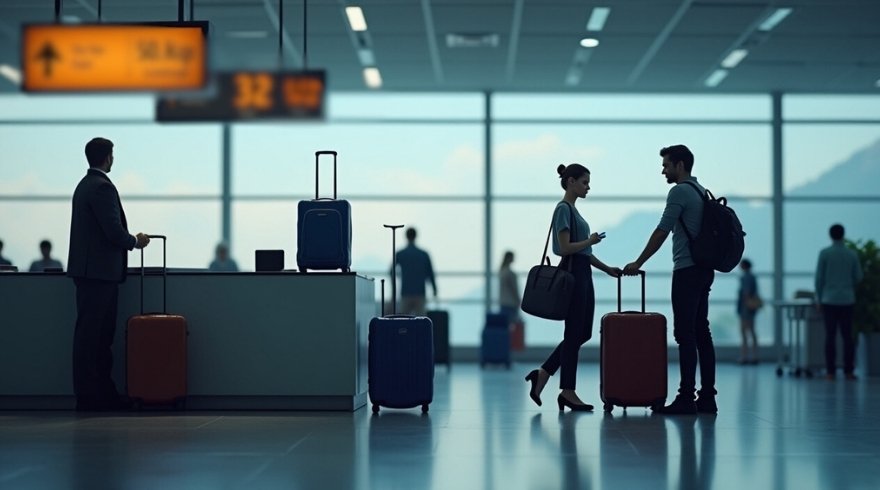
- Carry-On Size Limits: Airlines enforce strict size restrictions to ensure luggage fits in overhead compartments. Most carry-ons must stay within 18-22 inches for approval.
- Checked Baggage Dimensions: Larger suitcases must comply with airline size policies to avoid excess charges. Most airlines allow checked luggage between 23-32 inches in height.
- Weight Restrictions: Each airline sets weight limits for both carry-ons and checked luggage. Exceeding the limit results in costly overweight baggage fees.
- Liquid and Gel Restrictions: Security regulations limit liquid container sizes in carry-on bags. Each container must not exceed 100ml, and all must fit in a quart-sized bag.
- Prohibited Items List: Sharp objects, flammable substances, and explosives are strictly banned in both carry-on and checked baggage. Lithium batteries also have special handling rules for safety.
- Baggage Fees and Allowances: Budget airlines often charge extra for checked luggage, increasing travel costs. Some premium airlines include a free baggage allowance in ticket prices.
- Special Luggage Handling: Oversized or fragile items, like musical instruments, require special handling procedures. Travelers should check airline policies for sports gear and large equipment transportation.
- TSA and Security Screening: Passengers must comply with TSA screening rules to pass through security smoothly. Laptops, liquids, and electronics must be separated for inspection.
- Lost or Delayed Baggage Policies: Airlines have specific procedures for lost or delayed luggage claims. Travelers should report missing bags immediately to initiate the tracking process.
- Regional and International Differences: Luggage restrictions vary between domestic and international flights, affecting what passengers can carry. Checking airline rules before departure prevents unexpected issues.
Storage and Weight Considerations When Buying Luggage
Storage and weight considerations play a vital role in choosing the right luggage for any trip. The right balance ensures ease of movement, compliance with airline rules, and overall convenience. Overpacking or selecting the wrong suitcase size can lead to unnecessary hassle and additional costs. The Below factors help travelers make informed choices for a smooth journey.
Suitcase Size and Capacity
A suitcase that’s too small may not fit all essentials, while an oversized one becomes difficult to handle. Compact carry-ons work best for short trips, keeping packing light and efficient. Large checked luggage provides more space but may exceed airline size limits. Choosing the right size prevents overpacking and keeps travel stress-free.
Weight Restrictions and Airline Policies
Most airlines impose strict weight limits on both carry-on and checked baggage to maintain fair and safe travel conditions. Exceeding these limits results in expensive overweight fees, which can quickly add up. Packing strategically helps distribute weight evenly without crossing the allowed limit. Travelers should always check airline baggage policies to avoid last-minute surprises.
Storage Efficiency at Home and On the Go
Luggage storage matters beyond just the trip, as bulky suitcases can be difficult to store at home. Foldable or stackable luggage saves space and keeps travel gear organized. Compact options work better for travelers with limited storage capacity in apartments or small hotel rooms. Investing in space-saving solutions ensures easier packing and storage convenience.
Material and Durability Considerations
The choice between hard-shell and soft-shell luggage affects both storage and weight distribution. Hard-shell suitcases offer better protection but may be heavier and harder to compress in tight spaces. On the other hand, soft-shell luggage provides flexibility and extra storage pockets for better organization. Travelers often face challenges when deciding between hard and soft luggage, as each material has unique benefits suited for different travel needs.
Mobility and Handling Ease
Lighter luggage makes movement easier, especially in crowded airports or during long transits. Suitcases with spinner wheels and ergonomic handles reduce physical strain when navigating busy travel hubs. Overpacking a heavy suitcase can make lifting and maneuvering difficult, leading to unnecessary stress. Choosing luggage with a manageable weight ensures smoother and more comfortable travel experiences.
Impact on Travel Budget
Heavier luggage not only increases baggage fees but may also lead to additional transportation costs. Some airlines charge for every kilogram over the limit, making efficient packing essential. Lightweight luggage helps keep costs low while still providing enough space for necessary items. Being mindful of weight limits helps travelers avoid unexpected expenses.
Tips for Packing Smartly in Travel Luggage
Packing smartly makes travel easier, helping to avoid unnecessary stress and extra baggage fees. Efficient packing ensures essentials fit neatly without wasting space. Following simple strategies keeps luggage organized, making every trip more enjoyable and hassle-free.
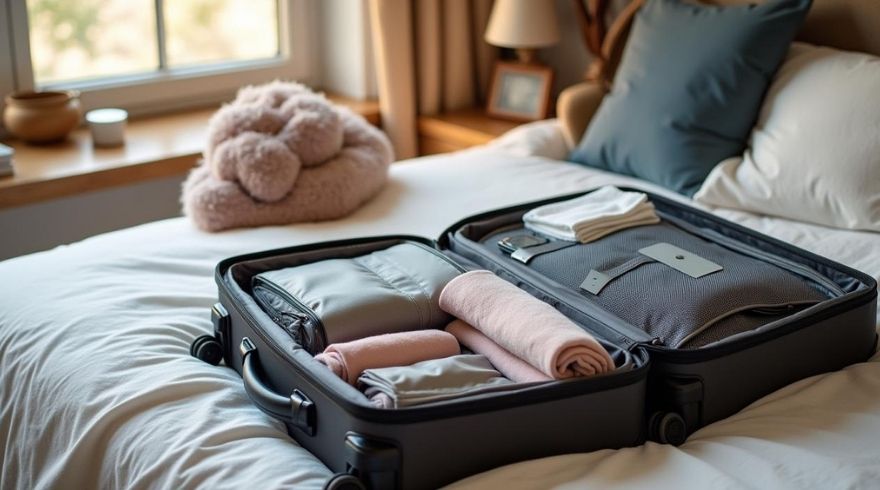
- Use Packing Cubes: Packing cubes separate clothing items, making it easier to find essentials. They help maximize space while keeping everything neatly arranged.
- Roll Clothes Instead of Folding: Rolling clothes prevents wrinkles and saves suitcase space. This technique allows more items to fit without creating clutter.
- Pack Multipurpose Clothing: Choosing versatile outfits reduces the number of items needed. Neutral-colored clothing pairs easily, allowing multiple combinations for different occasions.
- Limit Shoes to Essentials: Shoes take up significant space, so bringing only essential pairs is ideal. Comfortable and multipurpose footwear works best for travel.
- Use Travel-Sized Toiletries: Carrying smaller toiletry bottles prevents overpacking and meets airline liquid restrictions. Refillable travel containers save space and keep essentials handy.
- Layer Heavy Items at the Bottom: Placing heavier belongings at the suitcase base maintains balance. This prevents shifting and keeps delicate items safer during transit.
- Utilize Empty Spaces: Small gaps inside shoes or side pockets can hold socks, accessories, or toiletries. Maximizing every inch improves luggage efficiency.
- Keep Important Items in Carry-On: Essentials like documents, medication, and electronics should stay in a carry-on bag. This ensures easy access during the journey.
- Separate Dirty Clothes: Using a laundry bag keeps worn items away from clean clothes. This method maintains freshness and avoids unnecessary washing after travel.
- Pack a Compact Day Bag: A small foldable backpack or tote bag proves useful for daily outings. It saves carrying extra bulk throughout the trip.
FAQs about Finding the Right Luggage Size
Choosing the right luggage size depends on multiple factors, including trip length, packing habits, and airline restrictions. A well-sized suitcase enhances travel convenience, making packing and transport easier. Below are common questions travelers ask when deciding on luggage size.
What Size Luggage Is Best for Road Trips?
For road trips, a medium-sized suitcase (23-26 inches) works best to fit easily in car trunks. Soft-shell luggage provides flexibility, allowing better use of vehicle space. Packing cubes help organize essentials efficiently, making unpacking and repacking more convenient during multiple stops.
Should I Choose an Expandable Suitcase?
Expandable luggage is useful for travelers who shop or bring back souvenirs. The extra space provides flexibility without needing another bag. However, expanded suitcases may exceed airline size limits, so checking dimensions before flying is essential to avoid additional baggage fees.
What Luggage Size Works Best for International Travel?
A medium to large suitcase (25-29 inches) is ideal for international travel due to longer stays. It provides enough space for clothing, accessories, and travel essentials. Checking airline baggage allowances is crucial to avoid overweight fees or restrictions on checked luggage.
How Do I Choose the Right Carry-On Size?
A carry-on should be within 18-22 inches to fit airline restrictions. Compact and lightweight options are best for short trips and quick airport movement. Soft-shell carry-ons offer extra flexibility, while hard-shell ones provide better protection for fragile items like electronics.
What Luggage Size Is Best for a Family Vacation?
Family vacations require large (27-32 inches) suitcases to accommodate multiple people’s belongings. Packing together in fewer bags minimizes baggage fees and simplifies transportation. Organizing clothes in separate compartments or packing cubes ensures everyone’s essentials are easy to access during the trip.
Can I Use One Luggage Size for All Types of Trips?
A medium-sized suitcase (24-26 inches) offers versatility for different trip lengths. It’s spacious enough for longer stays but compact enough for shorter getaways. Expandable options further enhance flexibility, allowing travelers to adjust space based on packing needs.
Is There a Standard Luggage Size for Cruises?
Cruises often have limited cabin storage, so medium-sized luggage (23-26 inches) is ideal. Soft-shell suitcases fit better under beds or in small closets. Choosing luggage with organized compartments ensures easy access to clothing, toiletries, and travel documents throughout the trip.
Closing Remarks
Selecting the right luggage plays a crucial role in ensuring a smooth and stress-free travel experience. Factors like trip duration, airline regulations, storage needs, and weight considerations all influence the best choice.
If you've ever asked yourself, what size luggage should I buy, the answer depends on your personal travel style and destination requirements. Packing smartly, choosing durable materials, and adhering to airline restrictions help avoid unnecessary hassles and extra fees.
Whether for a weekend getaway or an extended trip, making an informed decision improves convenience, mobility, and organization. A well-chosen suitcase makes every journey more enjoyable and efficient.





